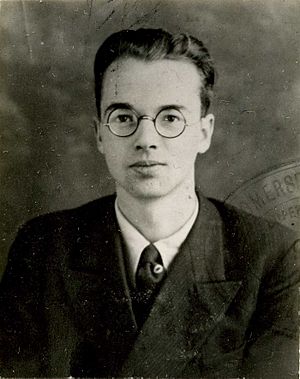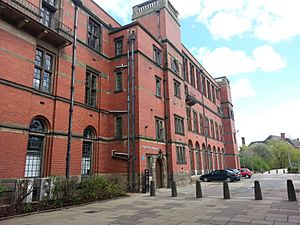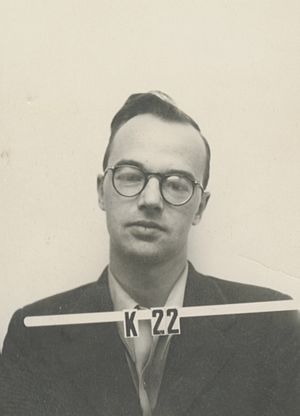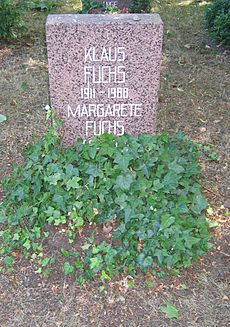Klaus Fuchs facts for kids
Quick facts for kids
Klaus Fuchs
|
|
|---|---|

Police photograph of Klaus Fuchs (c. 1940)
|
|
| Born |
Klaus Emil Julius Fuchs
29 December 1911 |
| Died | 28 January 1988 (aged 76) |
| Citizenship | Germany, United Kingdom (until 1951) |
| Alma mater | University of Leipzig University of Kiel University of Bristol University of Edinburgh |
| Spouse(s) | Grete Keilson (1959–1988) |
| Parent(s) | Emil Fuchs Else Wagner |
| Scientific career | |
| Fields | Theoretical physics |
| Institutions | Los Alamos National Laboratory Harwell Atomic Energy Research Establishment Institute for Nuclear Research in Rossendorf |
| Doctoral advisor | Nevill Mott |
Klaus Emil Julius Fuchs (born December 29, 1911 – died January 28, 1988) was a German theoretical physicist. He was also known as an atomic spy. He shared important information from the American, British, and Canadian Manhattan Project with the Soviet Union. This happened during and shortly after World War II.
While working at the Los Alamos National Laboratory, Fuchs did many key calculations. These were for the first nuclear weapons and later for early designs of the hydrogen bomb. After he was found responsible for his actions in 1950, he spent nine years in prison in the United Kingdom. Then, he moved to East Germany. There, he continued his work as a physicist and a science leader.
Contents
Early life and studies
Klaus Emil Julius Fuchs was born in Rüsselsheim, Germany, on December 29, 1911. He was one of four children. His father, Emil Fuchs, was a Lutheran pastor. His father later became a pacifist and a socialist.
Fuchs went to the University of Leipzig in 1930. His father was a professor there. Klaus became involved in student politics. He joined the student branch of the Social Democratic Party of Germany (SPD). He also joined the Reichsbanner Schwarz-Rot-Gold, which was the party's youth group.
In 1932, Fuchs joined the Communist Party of Germany (KPD). When Adolf Hitler became leader in 1933, Fuchs decided to leave Kiel. He went into hiding after the 1933 Reichstag fire. This event led to a crackdown on opposing political groups. In August 1933, he left Germany and moved to the United Kingdom.
Life as a refugee in Britain
Fuchs arrived in England on September 24, 1933. He met Nevill Mott, a physics professor at the University of Bristol. Mott agreed to let Fuchs work as a research assistant. Fuchs earned his PhD in physics from Bristol in 1937.
After this, he worked at the University of Edinburgh. He was an assistant to Max Born, another famous physicist. Fuchs earned another degree, a Doctorate in Science, from Edinburgh.
His family in Germany faced difficulties. His father was arrested for speaking against the government. His siblings were also arrested for their political views. Some of his family members later helped smuggle people out of Germany.
Work during World War II
When Second World War started in September 1939, Fuchs was still a German citizen. Because of the war, he was held in camps. First, he was on the Isle of Man, then in Canada. Even while held, he kept working on physics papers.

In 1941, Fuchs returned to Britain. He started working with Rudolf Peierls at the University of Birmingham. They worked on "Tube Alloys", which was Britain's secret atomic bomb project. Fuchs became a British citizen in 1942.
Soon after, Fuchs began sharing information about the project with the Soviet Union. He connected with Ursula Kuczynski, who was a German communist and a Soviet agent. She was known by her codename "Sonya."
In late 1943, Fuchs moved to New York City. He worked at Columbia University on the Manhattan Project. This was America's secret project to build an atomic bomb. In August 1944, Fuchs joined the Theoretical Physics Division at the Los Alamos Laboratory. He worked under Hans Bethe.
His main job was to solve problems related to how the plutonium bomb would work. He did important calculations for nuclear weapons. Fuchs was present at the Trinity test in July 1945. This was the first test of a nuclear weapon. He also worked on early ideas for the hydrogen bomb.
Klaus Fuchs was known as "Karl" at Los Alamos. He was friends with Richard Feynman, another famous physicist. Fuchs often lent his car to Feynman.
After the war
After the war, Fuchs stayed at Los Alamos for a while. He helped prepare for more weapons tests. He continued to share highly secret information with both British scientists and his Soviet contacts.
In August 1946, Fuchs returned to the UK. He became the head of the Theoretical Physics Division at the Atomic Energy Research Establishment in Harwell. From 1947 to 1949, he gave his Soviet contact, Alexander Feklisov, key ideas for creating a hydrogen bomb. He also shared results from tests of uranium and plutonium bombs.
Discovery and admission
By September 1949, British intelligence learned that Fuchs was a spy. This information came from a secret project called Venona project. The Soviets had stopped contacting him in February 1949.
In January 1950, Fuchs was told he had to leave his job at Harwell. This was because his father had taken a position in East Germany. On January 24, 1950, Fuchs admitted that he had shared information with the Soviets. He said he had done this for seven years, starting in 1942.
Fuchs explained that he believed knowledge of atomic research should not belong to just one country. He thought it should be shared for the good of all people. Some historians believe he wanted to balance world power and prevent any one country from using nuclear weapons as a threat. Others think he did it because he believed in communism.
His statements helped identify other people involved in sharing secrets. Fuchs was arrested on February 2, 1950.
Impact of his information
Some experts believe that Klaus Fuchs greatly helped the Soviets. Hans Bethe once said that Fuchs was the only physicist he knew who truly changed history. Fuchs shared details on how uranium could be processed for a bomb. He also shared the amounts of uranium or plutonium the Americans planned to use.
It is debated how much his information on the hydrogen bomb helped. The successful design for the hydrogen bomb was not created until 1951. Soviet scientists later said that early designs, including Fuchs's, were not useful. However, some recent research suggests his early work did push Soviet research in the right direction.
Some historians believe Fuchs's actions allowed the Soviets to develop their bomb faster. This might have created a balance of power. This balance might have prevented the United States from using its atomic bomb on North Korea.
Time in prison and later life
Fuchs was found responsible for sharing secret information. On March 1, 1950, he was sentenced to 14 years in prison. This was the longest sentence allowed at the time for sharing secrets with an ally. In 1951, he lost his British citizenship.
Fuchs was released from Wakefield Prison on June 23, 1959. He had served nine years and four months. After his release, he immediately moved to the German Democratic Republic (East Germany).
Career in East Germany
In East Germany, Fuchs continued his scientific career. He became a respected leader in research. He married Grete Keilson, a friend from his student days, in September 1959.
He became a member of the SED central committee in 1967. In 1972, he joined the Academy of Sciences. He was later appointed deputy director of the Institute for Nuclear Research in Rossendorf. He worked there until he retired in 1979.
Fuchs received several awards in East Germany. These included the Patriotic Order of Merit and the Order of Karl Marx.
Some people have suggested that Fuchs helped Chinese physicists develop their first atomic bomb. However, other historians have called this idea "unsubstantiated conjecture."
Death
Klaus Fuchs died in Berlin on January 28, 1988. He was buried in the Pergolenweg section of Berlin's Friedrichsfelde Cemetery.
Images for kids
See also
 In Spanish: Klaus Fuchs para niños
In Spanish: Klaus Fuchs para niños





